How to fish when there is a seal nearby? – Swedish experience from the viewpoint of Polish fishers
Iwony Psuty’s report from Järnavik in southern Sweden

Just before Easter (11–13 April 2017) thanks to the combined efforts of Mr. Marcin Ruciński from LIFE organisation, Dr. Peter Ljungberg from SLU Aqua (Swedish University of Agricultural Sciences), Swedish fishers involved in project “Program Sälar och Fiske”, and the NMFRI scientists, a group of Polish fishers, representatives of the: Central Pomerania Fisheries Group, Darłowo Group of Fish Producers and Fishermen Boats, Association Boat of Fishers “Mierzeja”, and Sea Fisheries Union – Producer Organisation, visited a small settlement Järnavik in southern Sweden. The aim of the visit was to observe how fishing traps are used in practice. Polish fishers have heard about them many times in the context of sea birds and mammals protection from bycatch but it aroused rather little enthusiasm among them compared with sufficient CPUE of traditional and simple to use set nets. On the other hand, the constant presence of grey seals in the Polish coast of the Baltic Sea, which treat fishing nets as a snack bar, persuaded the fishers to have a look at other catch methods. Different trap gears, tested by Swedish fishers who had faced the seal problem earlier, were perceived by many Polish fishers as useless in the open south coast of the Baltic Sea. They were accused primarily of low CPUE and difficulty in handling at small fishing vessels. The visit in Sweden and the opportunity to talk to local fishers intended to clarify these doubts directly during normal catches.
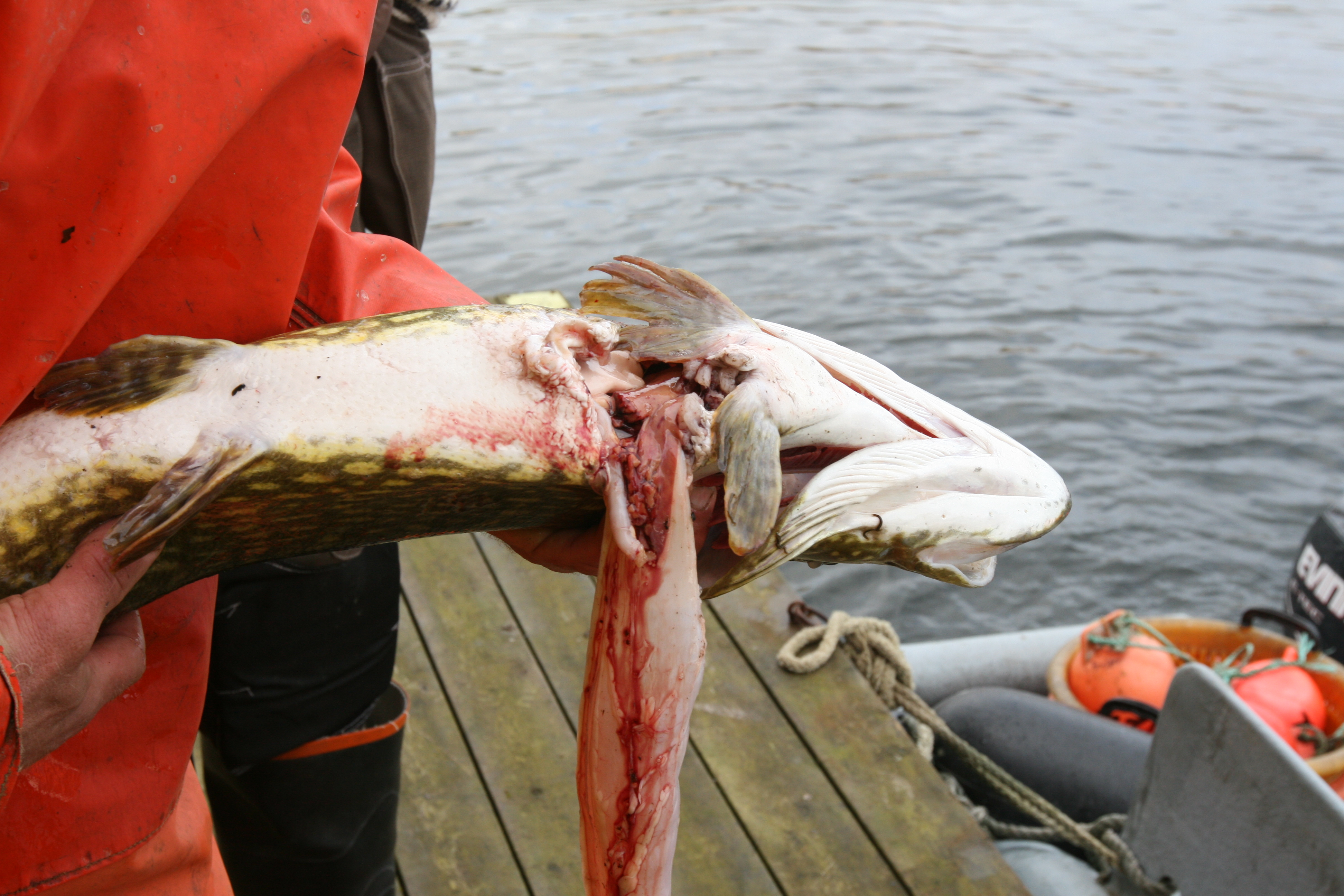
Photo: a female pike (about 60 cm long) damaged by a seal, was still alive at the moment of taking it out from the water. Probably we scared the hunting seal away (we did not see it from our boat), when passing by. Sadly, the seals, in view of the easier availability of fish in nets, do not eat whole fish as if it was necessary to satisfy hunger. Fishers often observe minor damage to fish in nets, usually in the soft, abdominal part of the body, and also skin tearing. Seals seem to treat the catch in nets as a “delicatessen buffet” – the eaten parts of fish only slightly meet the energy needs of animals, and at the same time none of the damaged fish is suitable for human consumption.
Preliminary plans for a visit to Sweden included two fishing days, during which Polish fishers and scientists could observe the use of various types of traps tested by Swedish fishers in practice. One cruise was to take place in the sheltered waters of Blekinge, a region with a large number of bays and islands, with ichthyofauna typical of transitional waters, i.e. between open sea and freshwater. The second cruise was planned to be spent on observations in the Ystad region, where we were supposed to see catches in open sea conditions, i.e. comparable to the Polish coast. Unfortunately, the weather conditions did not allow for the whole plan, leaving the possibility of going on such a large trip and sailing “board to board” only from Järnavik. So during the first day of our stay we had the opportunity to learn about the design and operation of various traps on land.
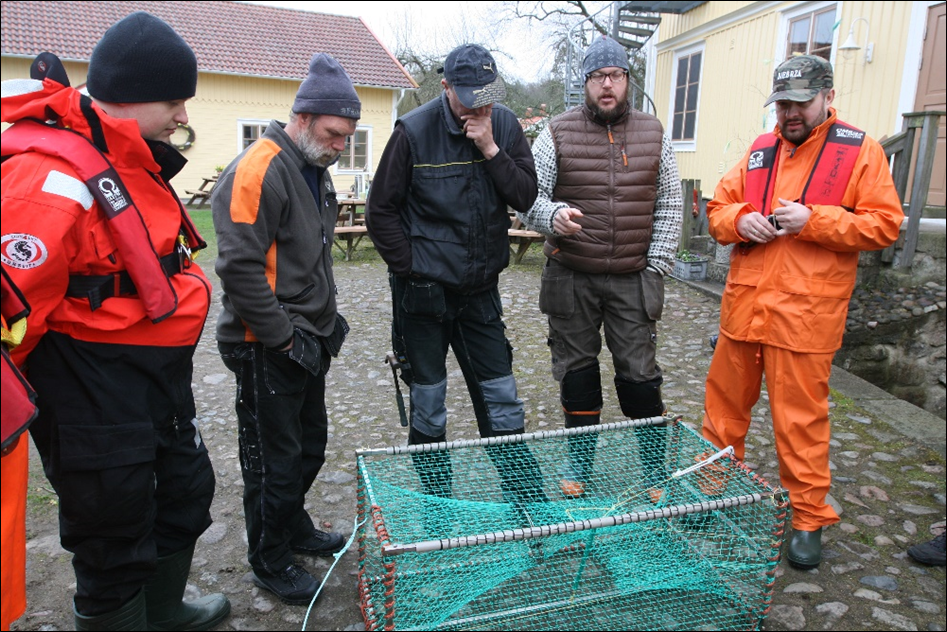
Photos: Peter Ljunberg with fishers – Bengt Larsson and Glenn Fridh –shows an experimental model of cod-flatfish cage. The model of cooperation within the current Swedish project assumes that fishers create and test new technical equipment in practice. This trap model has two different entrances – a circular entry for cod and a wide transverse for flatfish. In order to reduce the transport area with a small fishing vessel, the cage was designed as a foldable construction. In practice, even on land it appeared to be a bit difficult – the necessary equipment turned out to be a hammer. However, Peter emphasized that this is a prototype construction and as such has the right to have imperfections. It took about 3 minutes to fold and unfold the cage.
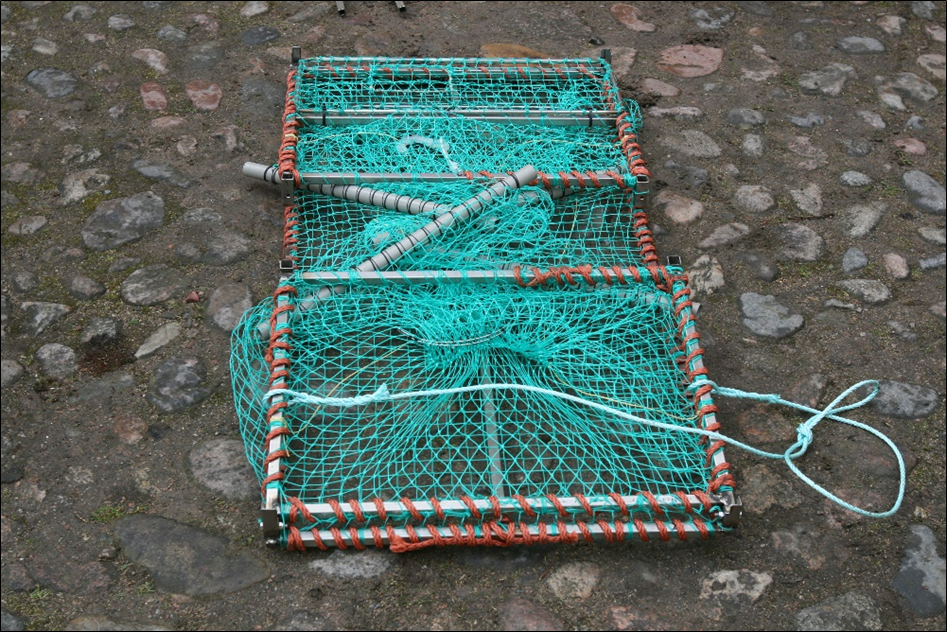
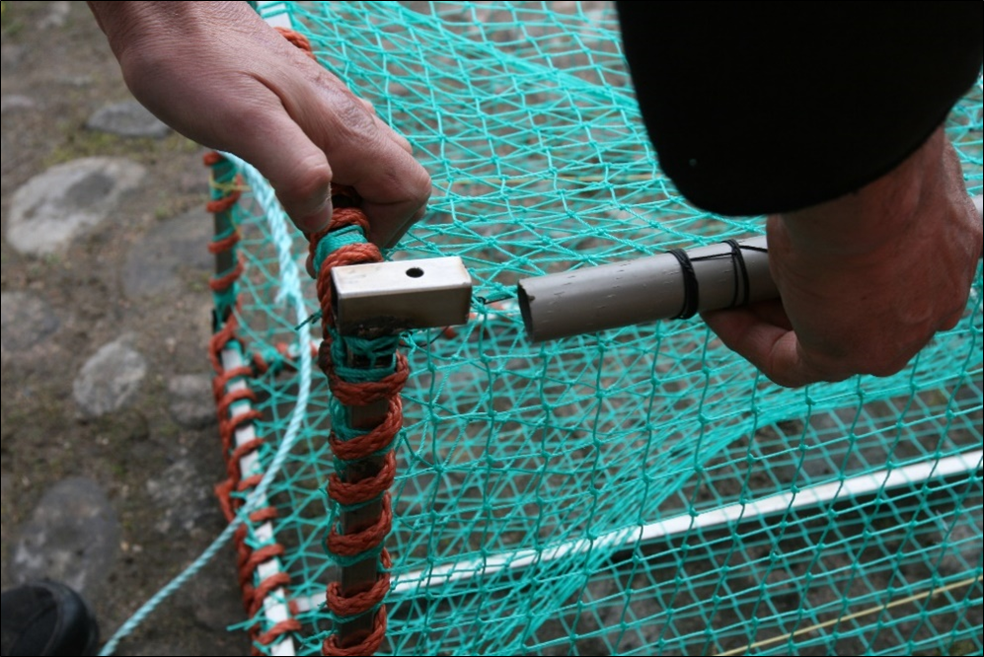
Bengt and Glenn usually use small cages 120x60x40 cm in size and with two circular entrances. Sliced herring is used as bait. The cages are constructed of solid rods. From the bottom they are provided with additional load and from the top they have openings through which the fish can be removed. According to Swedish fishers, cages of this size are comfortable to use and above all resistant to seal attacks. Polish fishers did not seem particularly convinced of such solutions. Their doubts were raised not only by CPUE of such gears (compared to set nets), but also by technical aspects. Do cages rotate in the water? Do they accumulate algae, jellyfish and shells making them more difficult to handle? How many cages can a small boat take? Is an ordinary hydraulic winch enough to pull them out?
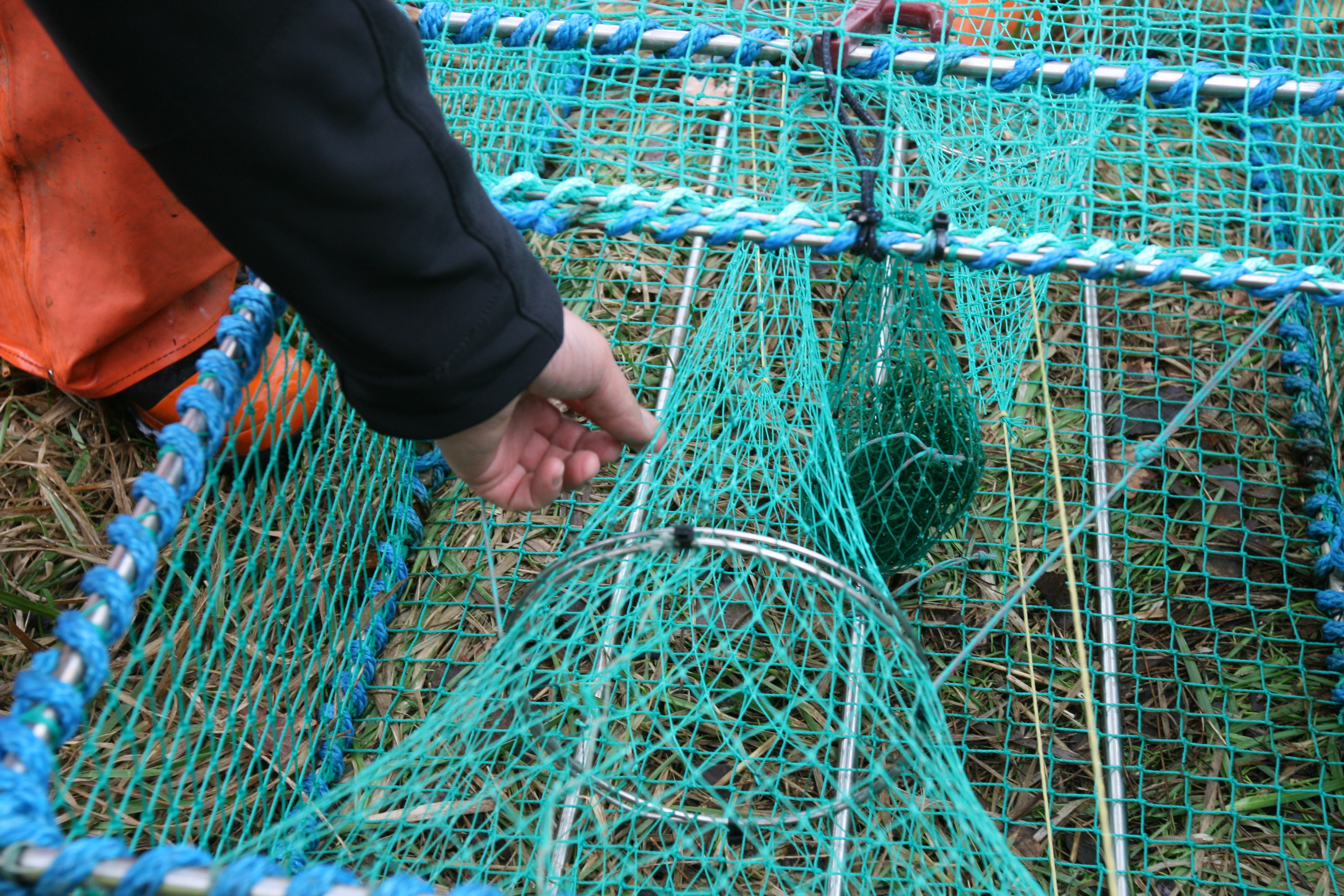
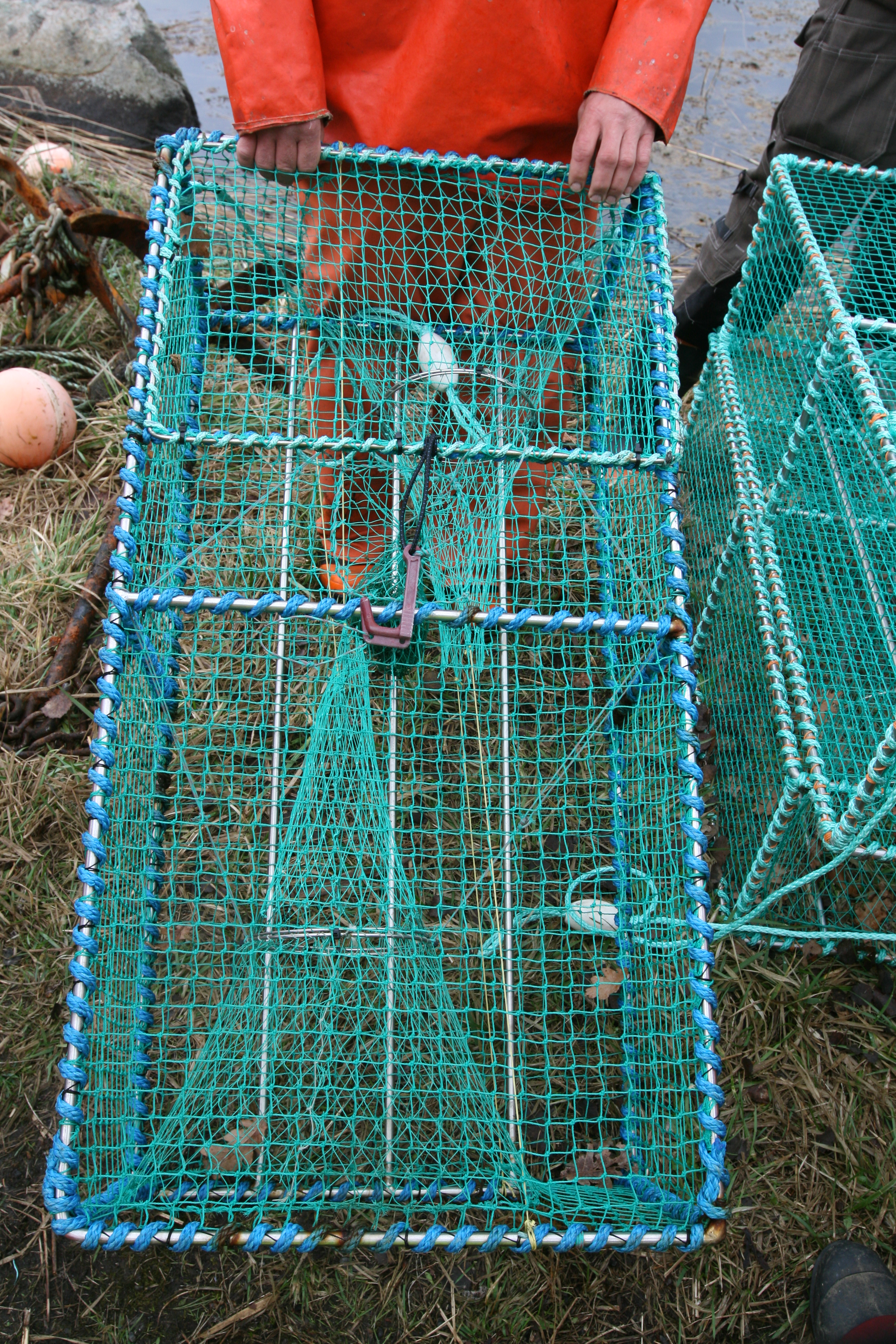
Photos: cod cages used by our Swedish hosts. According to Swedish fishers, robust construction, two entrances of circular cross-section and a relatively small diameter, as well as small mesh size prevent seals from attacking effectively the fish inside the cage.
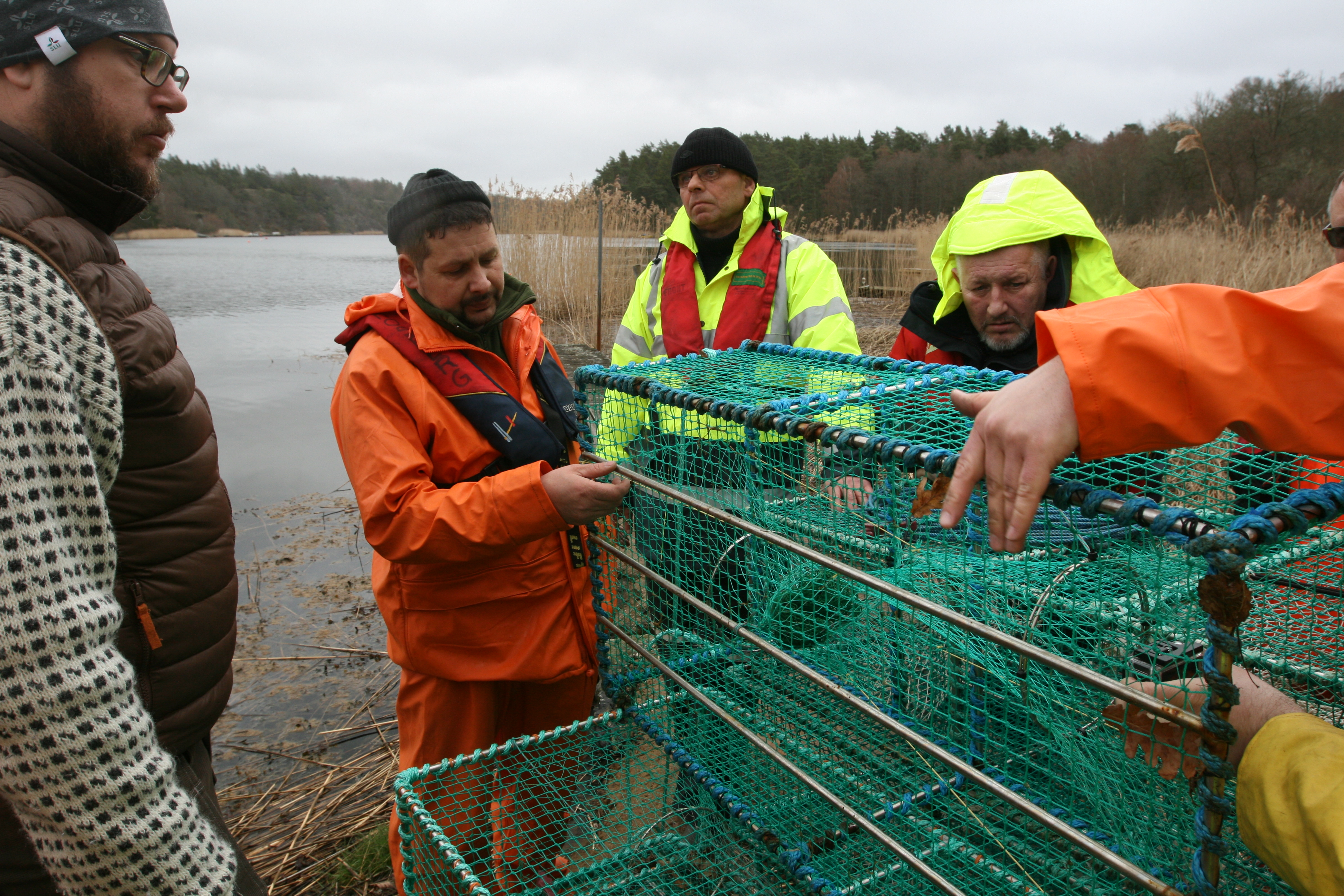
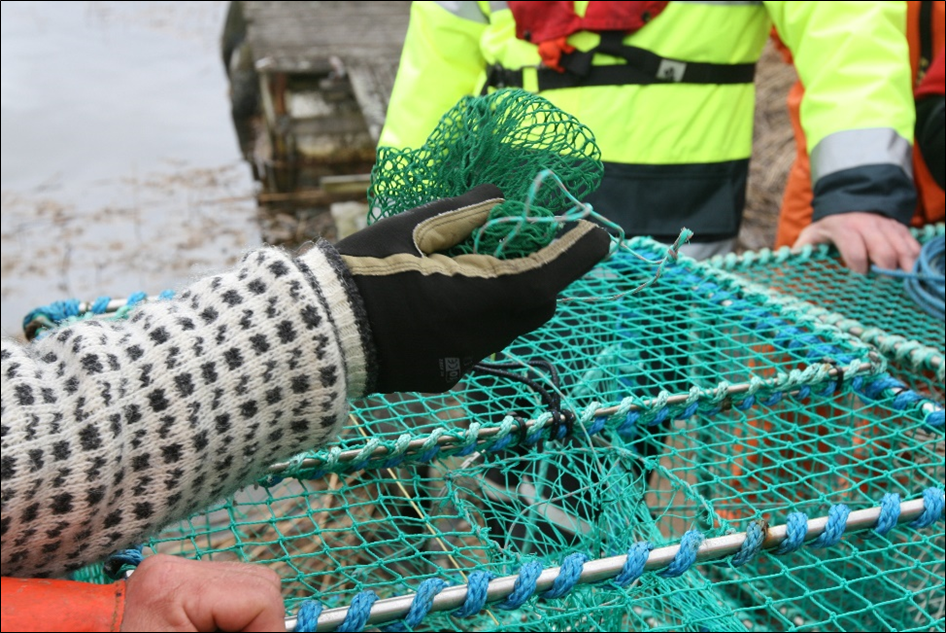
Photos: the bottom of the cage is equipped with three additional rods to prevent the cages from turning in the water. A bag for bait – our hosts usually use sliced herring – it is placed inside the cage just before it is deployed.
In addition to “typical” small cod cages, our hosts showed us several other solutions. One of them is a so called “large cod cage”, 160x160x50 cm in size, used in the open waters of the coast near Ystad, which we were supposed to see during catch retrieval. This was unfortunately impossible due to the weather conditions. According to Dr. Ljungberg this kind of cages is characterised by higher CPUE per single gear but require a larger vessel. The cages are folded constructions, without vertical stiffeners, floatable from the top. Unfortunately, according to Swedes, seals have already learnt how to “handle with” large cages. They throw at them, making the gear fold in the water, and hence gaining access to the fish caught there. The larger surface allows seals to manipulate easier with clawed fins or to bite soft tissue through the net mesh.
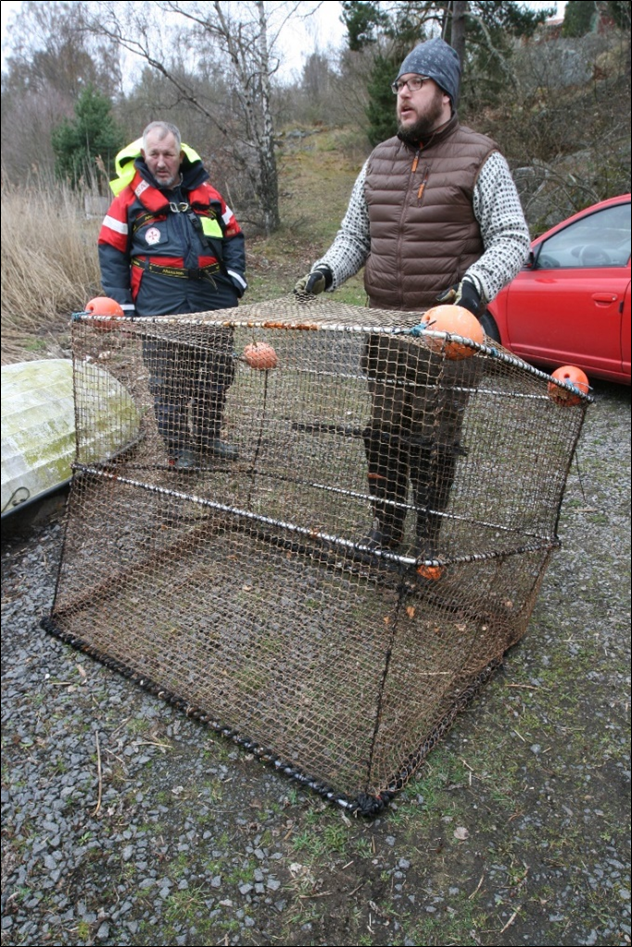
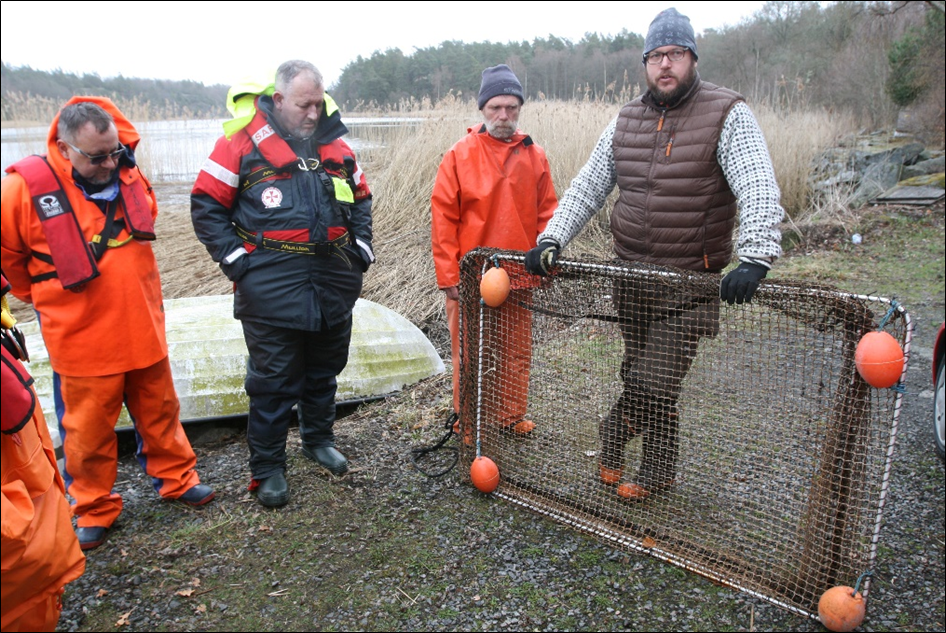
Photos: “large” cod cages are more efficient per single gear. They are folded and in transport they take up little space. In the picture Bengt Larsson shows how seals „handle with” such cages by throwing at them with all their weight and folding them in water. This makes it easier to get the captured fish.
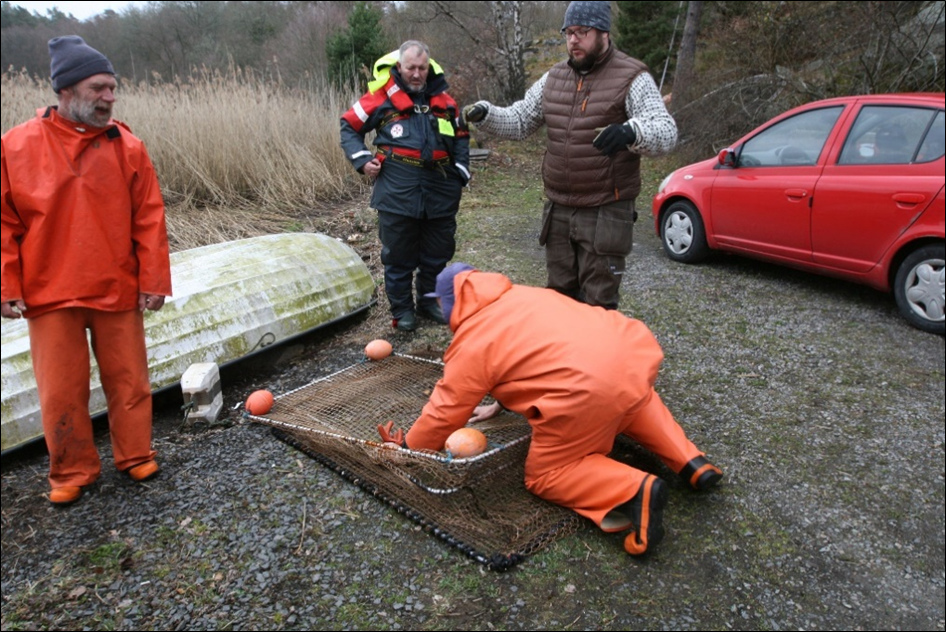
On the second day, the wind weakened, which made it possible to observe catches “board to board”. Not very large Bengt Larsson’s vessel took on board our entire tour. Glenn Fridh sailed a smaller motor boat. Both vessels did not impress with size, but we took a correction to the field conditions – the sheltered coast allows using even smaller boats. The plan involved observing the deployment and retrieval of two sets of small cod cages, one prototype trap and a large pontoon trap.
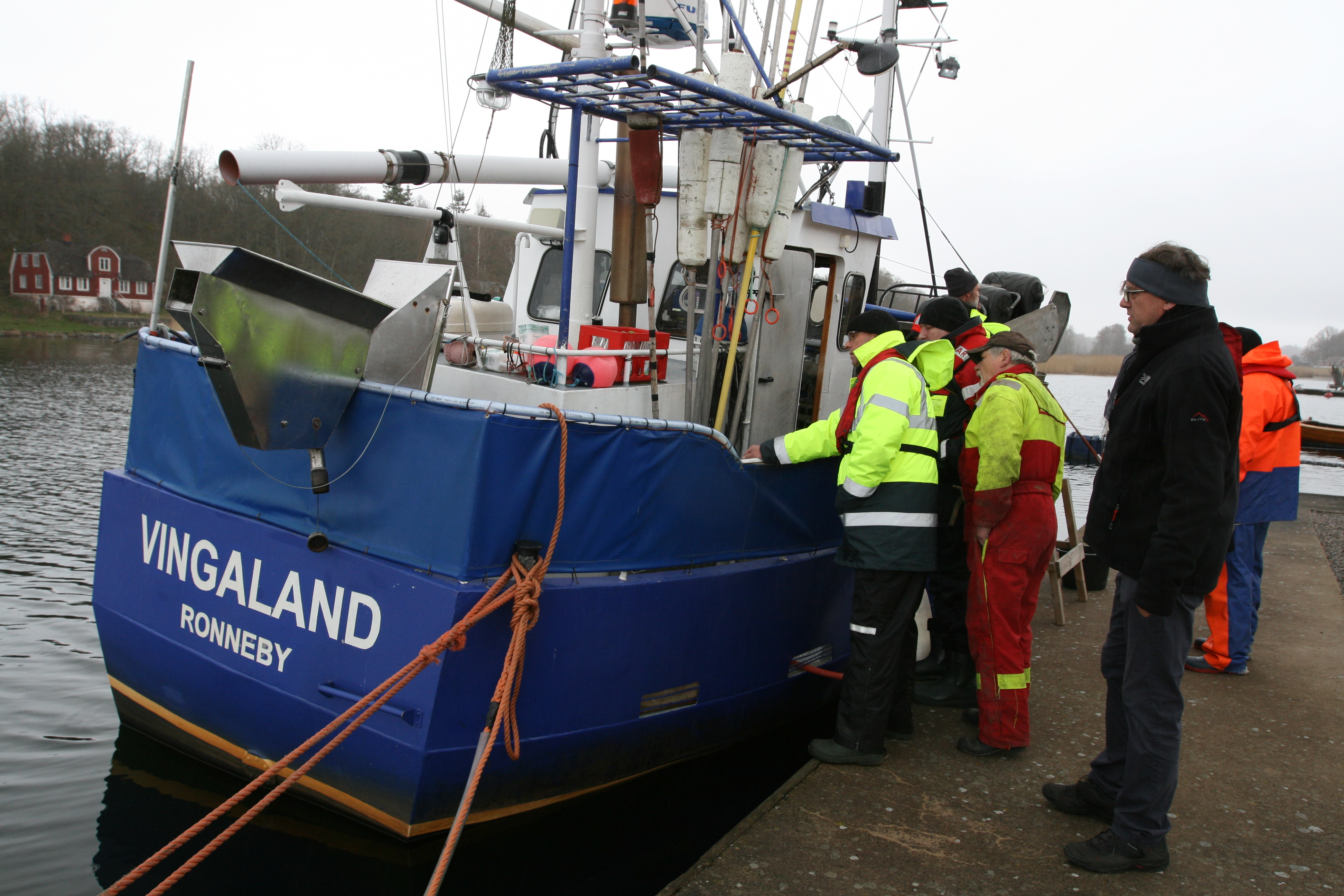
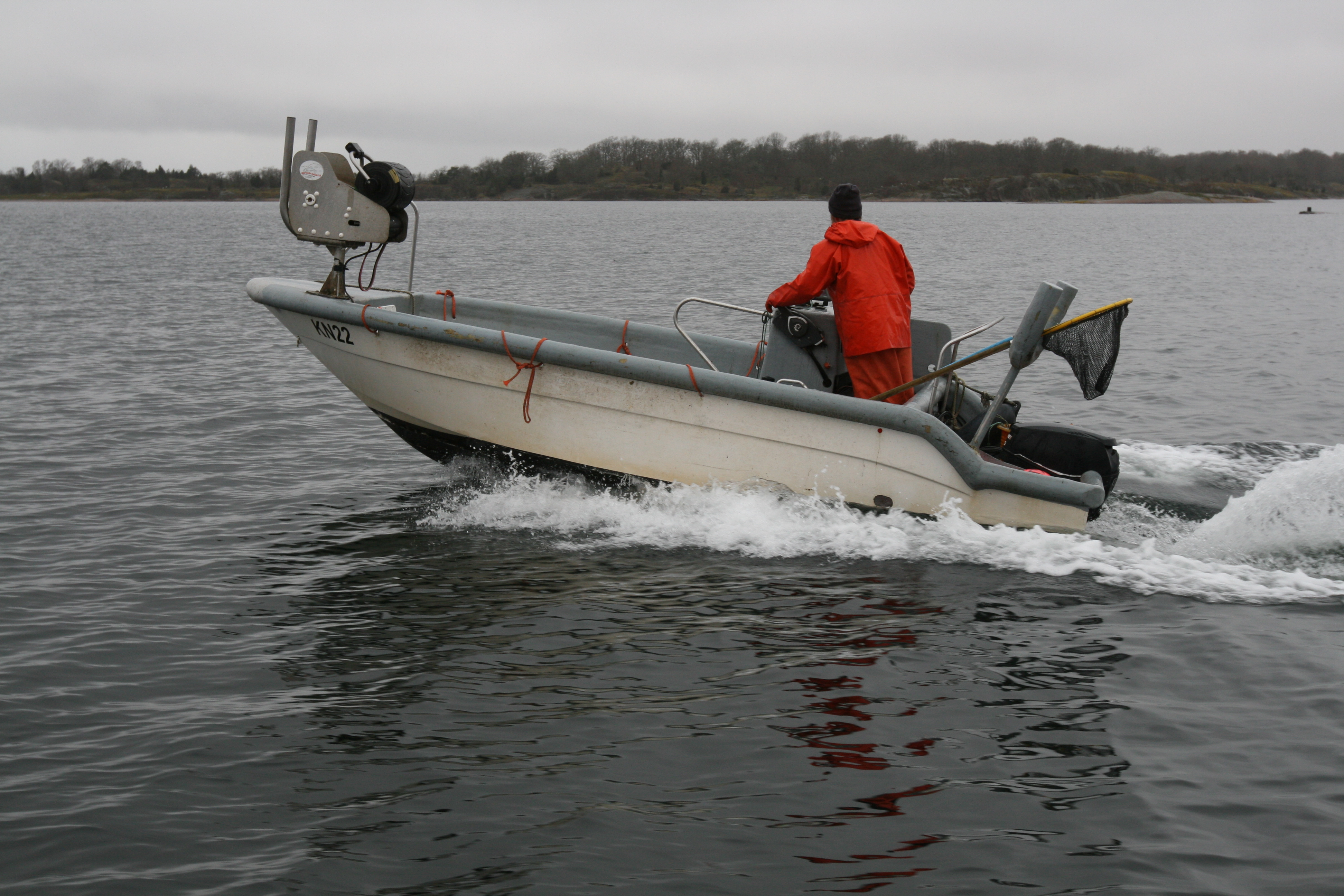
Photos: on the left – Bengt Larsson’s vessel, on the right – Glenn Fridh going to the first set of cages.
The winch was used to retrieve the rope, and Glenn took the cage without much effort. The first cage contained several cod – they were all alive. Cages were standing in the water for 4 days, but we learnt that effective fishing time is only 2 days – then the bait stops to function. Fish in the cage, however, can wait without harm to the quality of the raw material unless a fisher picks them up. That is a great advantage of trapping gear. By the way, we learnt that our hosts sell these fish as “ecological”, i.e. caught in a friendly way to sea birds and mammals – and thus get a much higher price. Noteworthy, the fishers pack fish themselves – gutted or fillets and supply them with a label showing not only the species name and date of catch, but even the name and contact to the fisher. In this way, every consumer can contact them directly, for example by ordering a batch of quality fish. Indeed, quality plays a big role – we saw that all cod in cages were alive, so that guarantees the freshness of fish.
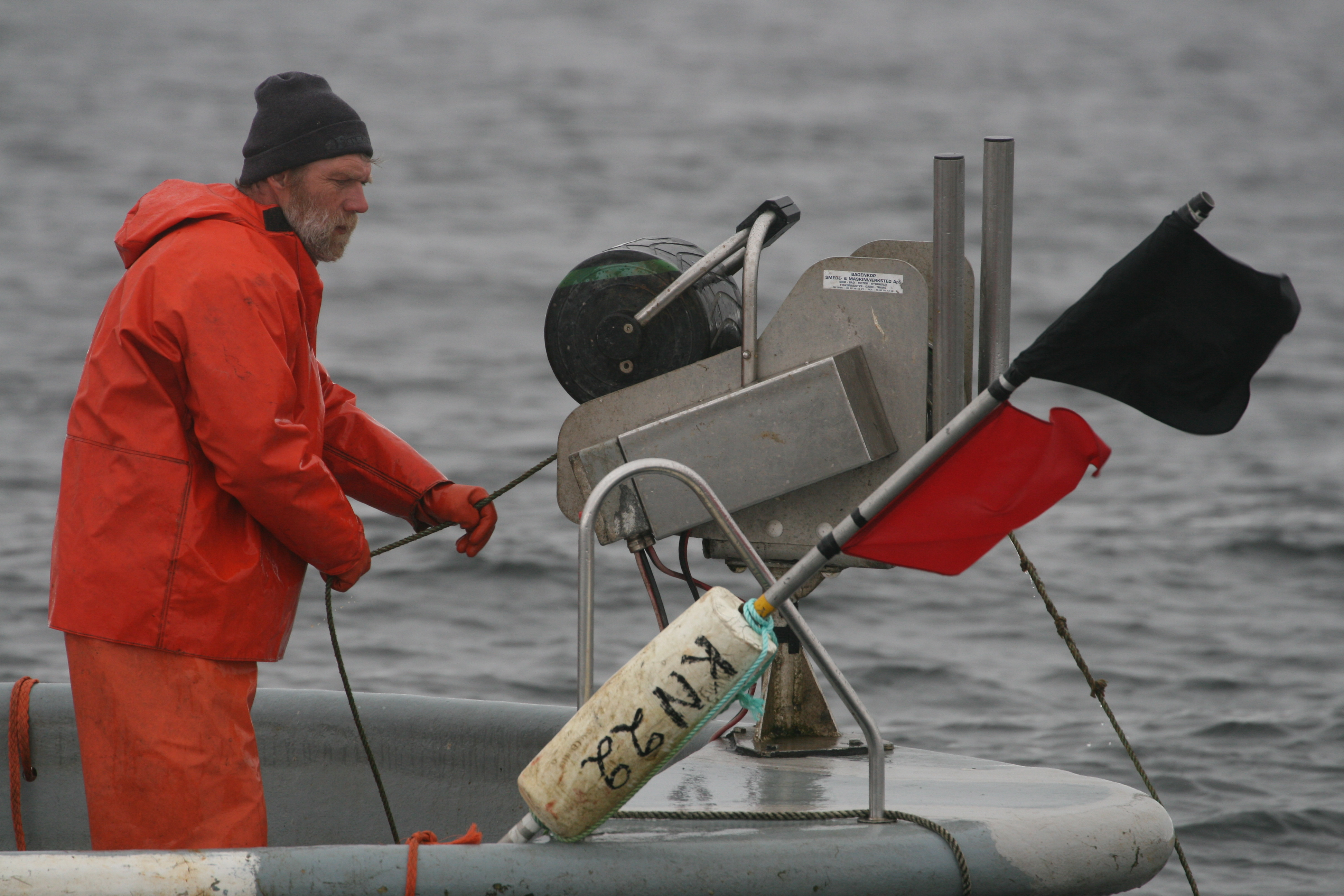
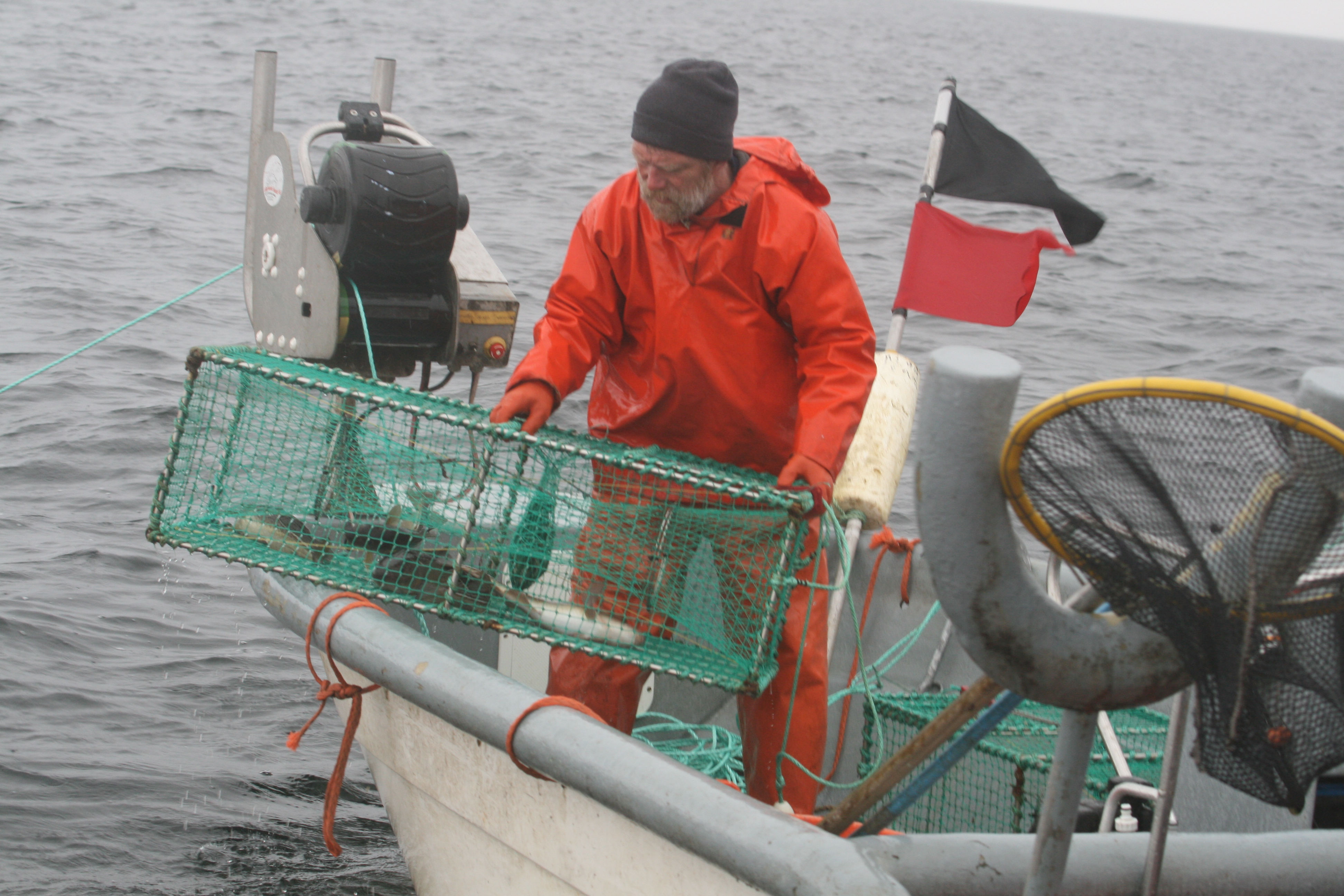
Photos: cages were deployed as 6 pieces in a set and remained in the water for four days (despite the fact that according to our hosts, the effective time of fishing is only two days – this time the cages were waiting for our arrival). The view of the first cod in traps began to change our already mixed opinions on the effectiveness of this fishing method.
Retrieving the whole set of cages, together with the removal of fish and changing the bait took about 10 minutes, i.e. a little more than retrieving a standard set of nets. Unfortunately, it is difficult to compare the CPUE for nets and cages in the presence of seals – in this region none of the fishers uses the nets (also there are fewer fishers these days) – most probably they would not find a whole fish.
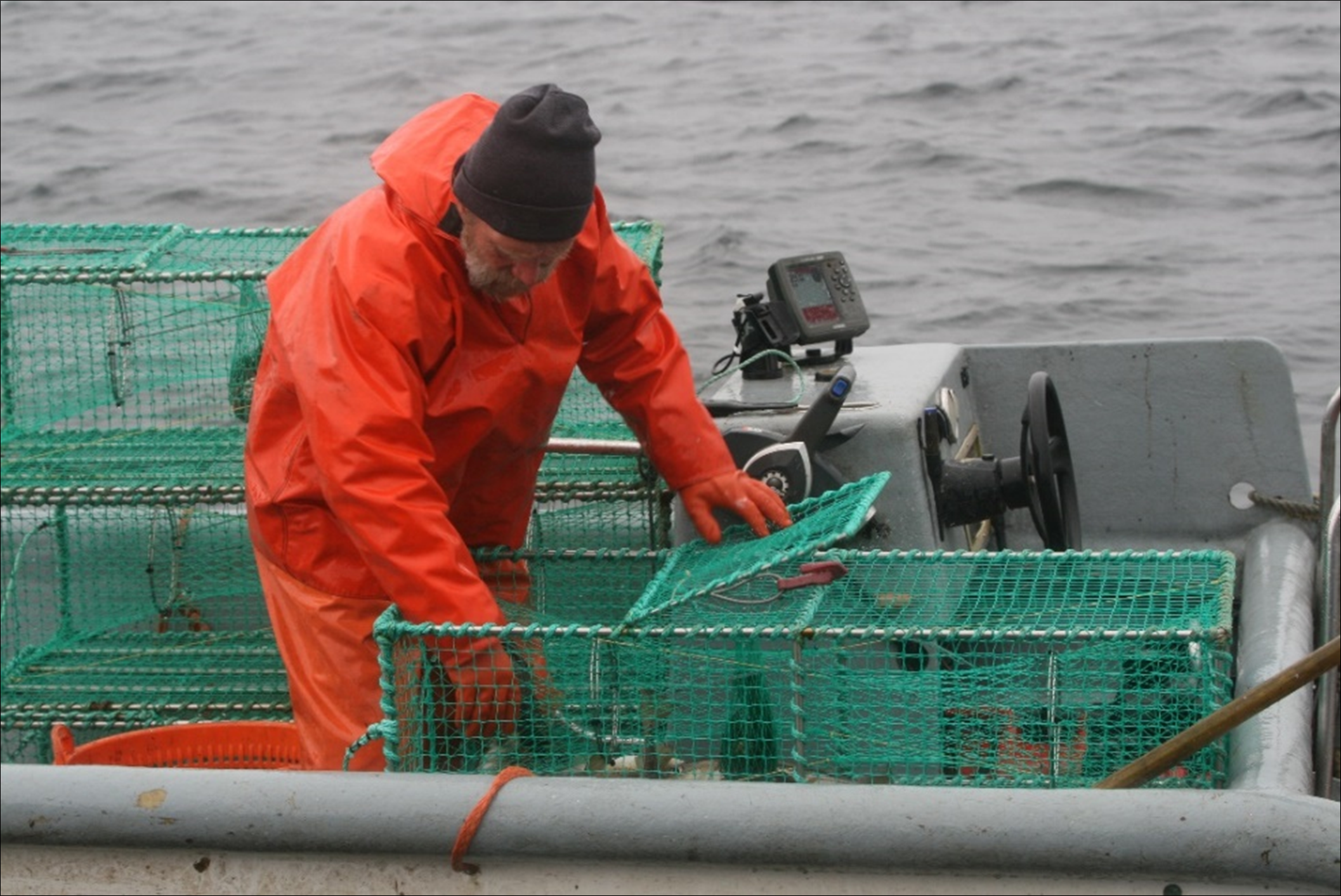
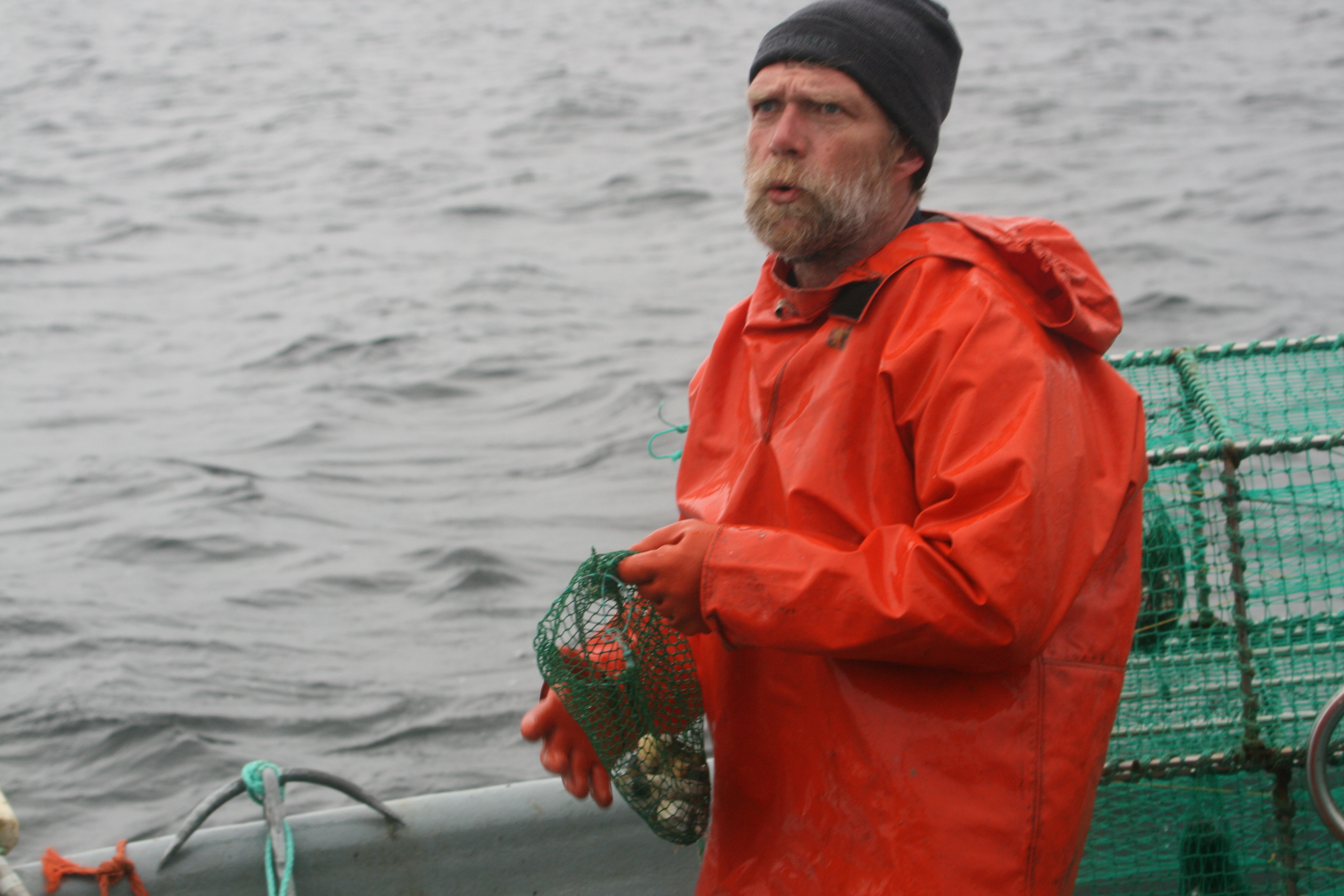
Photos: removing fish from cages is several seconds. The undersized or thin cod were immediately, live, released into the water. There were no other species in the cages. Replacing the bait is another 10-15 seconds. Polish fishers started a discussion at this point about the superiority of sand lance bait over the herring slices.
On the small Glenn’s boat there was no room for more than 6 retrieved cages. This meant each set had to be deployed before retrieving the next one. The whole fishing operation was short – retrieving the rope was the longest activity. Of course, one should consider a slight wave and wind that allowed for quick and safe handling of the cages
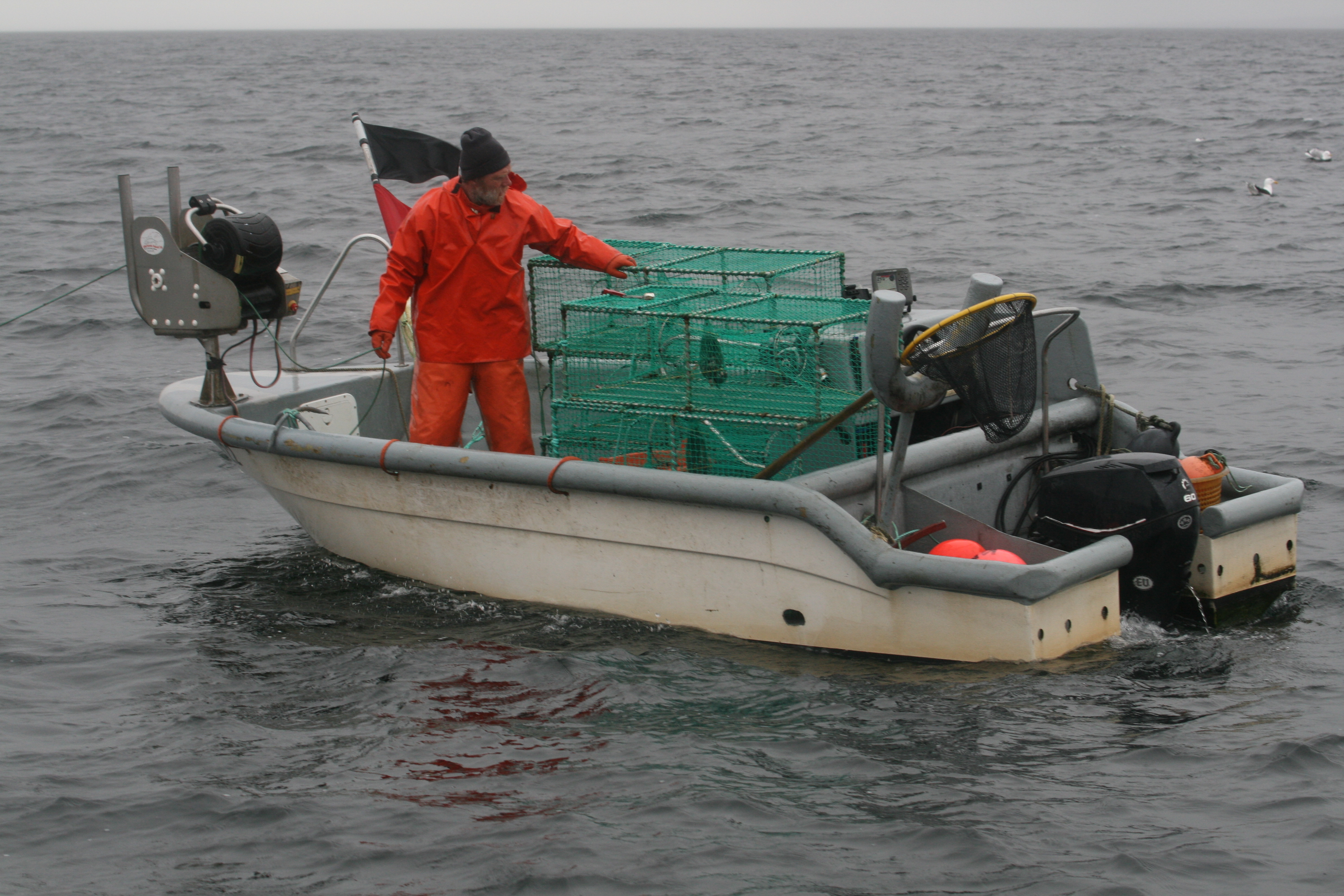
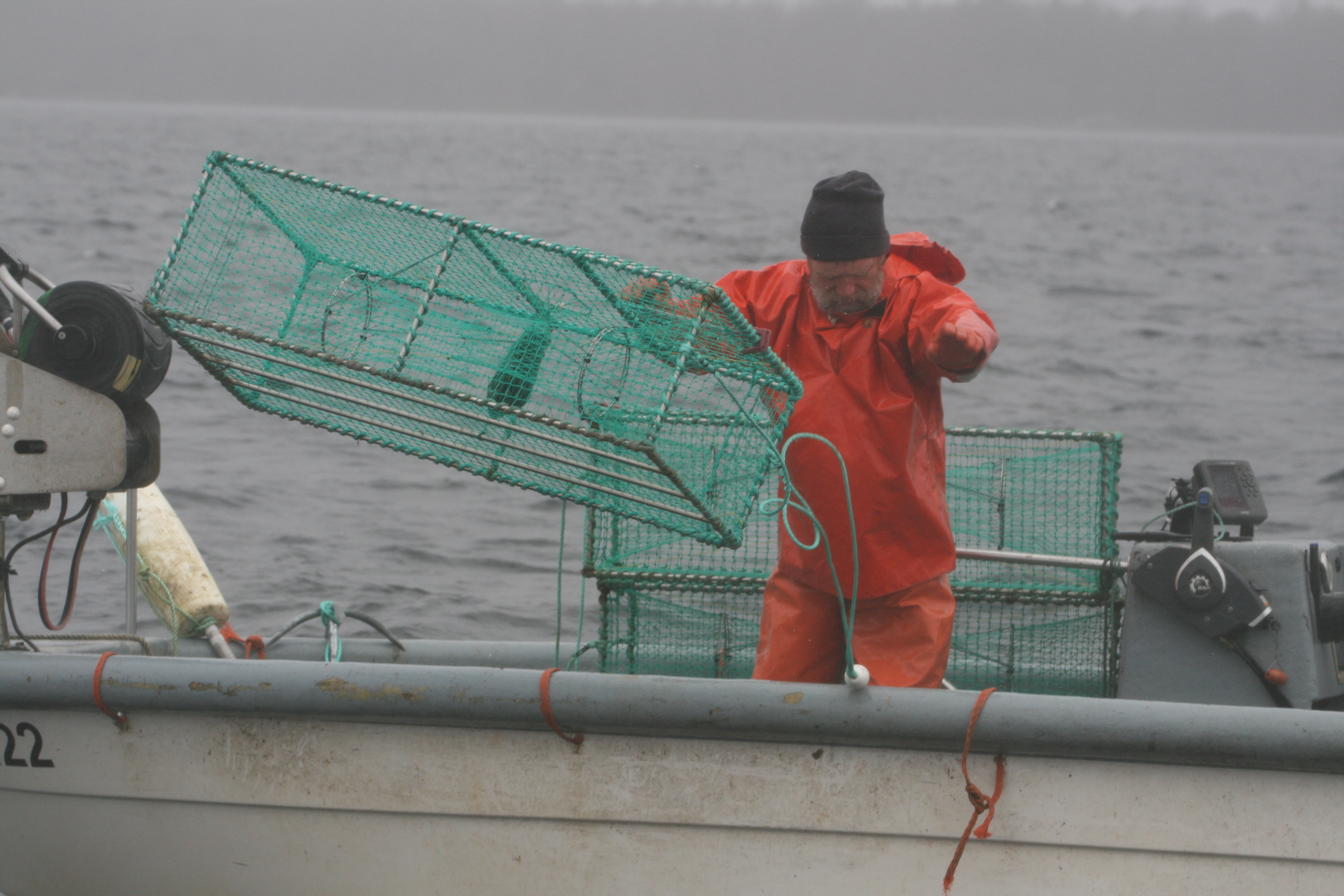
Photos: Re-deployment of the set of cages is a matter of 2-3 minutes.
After retrieval and re-deployment of two sets of cages, we went to other prototype cages tested in the water. On the way, Glenn gutted all the cod. It was difficult to judge how the catch was big – we estimated it to be about 20 kg of fish. On the way back, two other prototype cages were retrieved, both made floatable, floating over the bottom, but unfortunately with worse results than the sets.
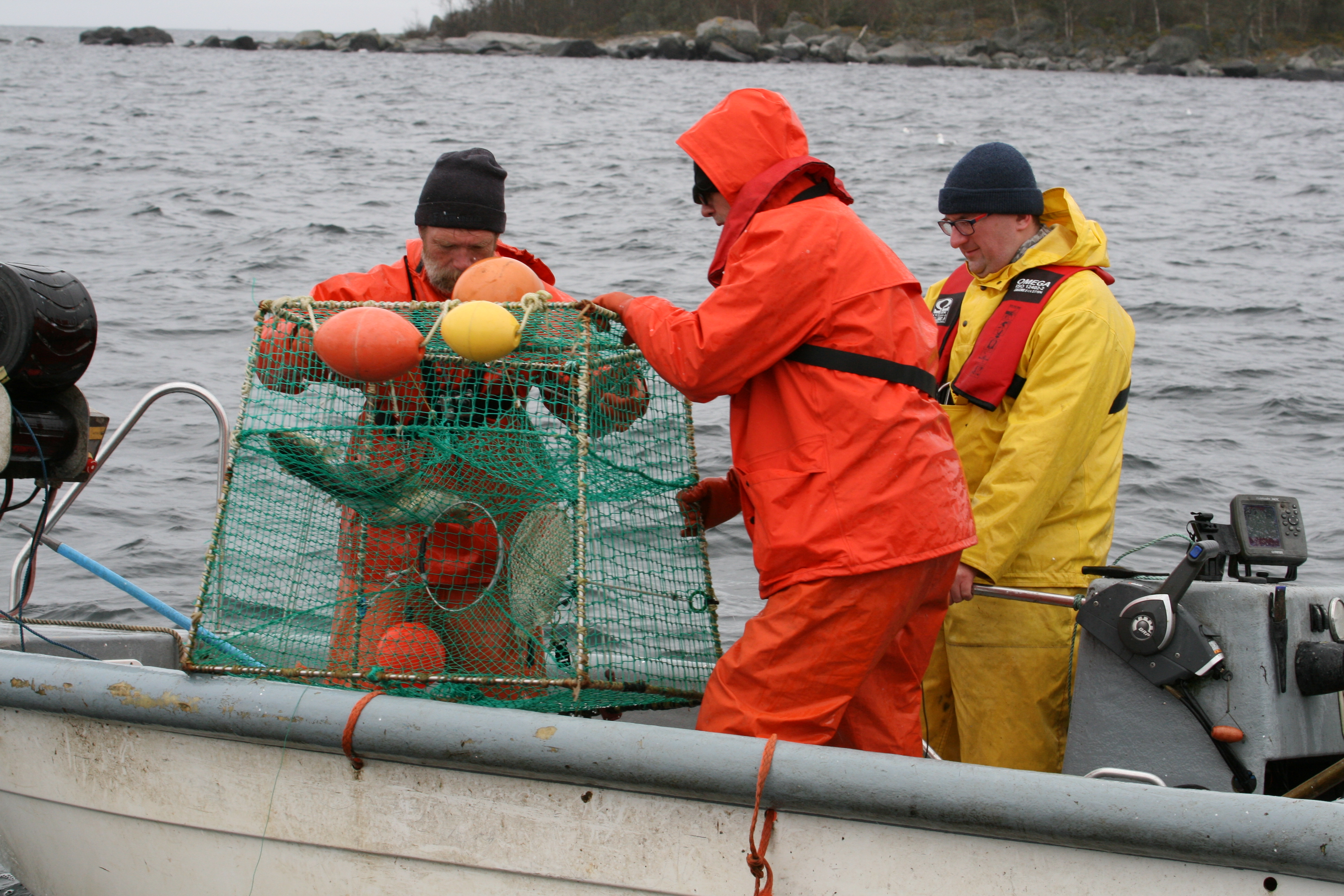
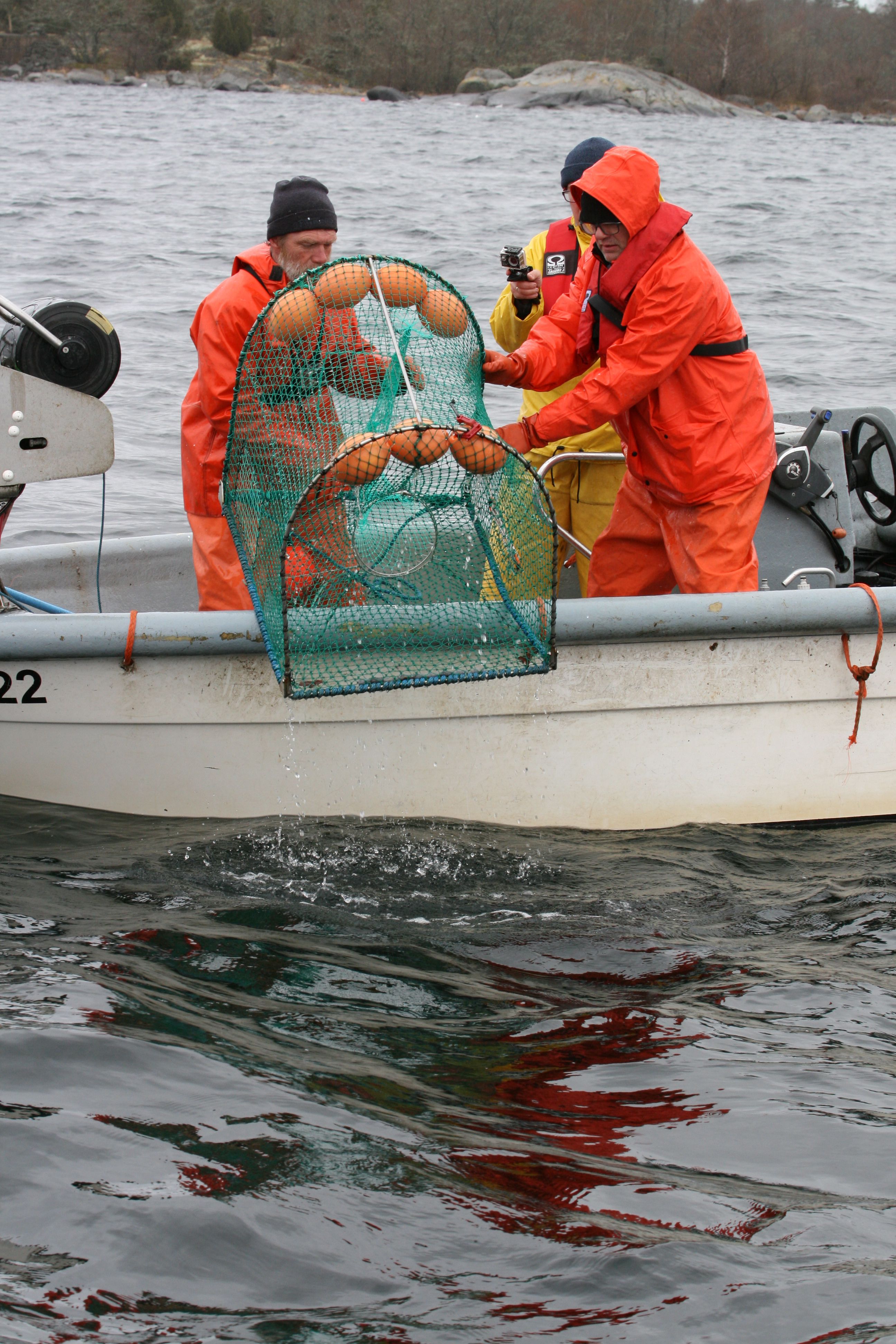
Photos: fishers test many types of traps within the project. The cages float over the bottom, reacting to the direction of sea currents. Unfortunately, in a D-shape cage we did not find any cod, and in a cuboid cage, despite its larger size than “small cages”, only two cod were captured.
The last thing to see was a pontoon trap, designed for multi-species catches. The way of deploying this type of gear is similar to a Polish scheme – perpendicularly to the shore. The movable part equipped with floats is the cage itself – the wings and wall of the trap are loaded and, during the removal of fish, they remain under the water. A small generator is sufficient to fill the floats with air – as in the case of cages Glenn handled the entire fishing operation himself. However, in the case of the pontoon trap, we all stated that this tool was not suitable for Polish conditions. Even in the Szczecin Lagoon the wave motion is usually larger, which would make the whole operation risky in our opinion.
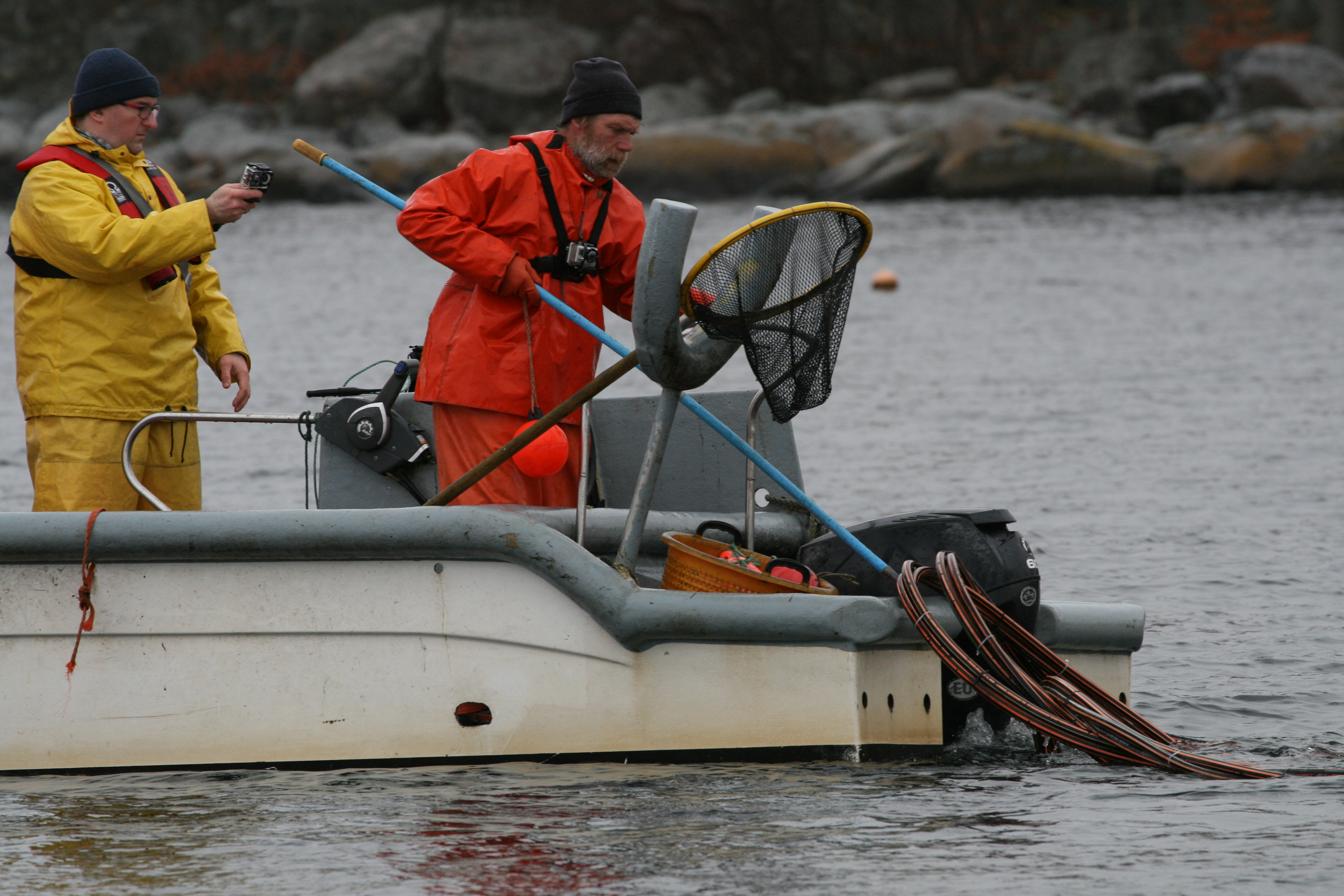
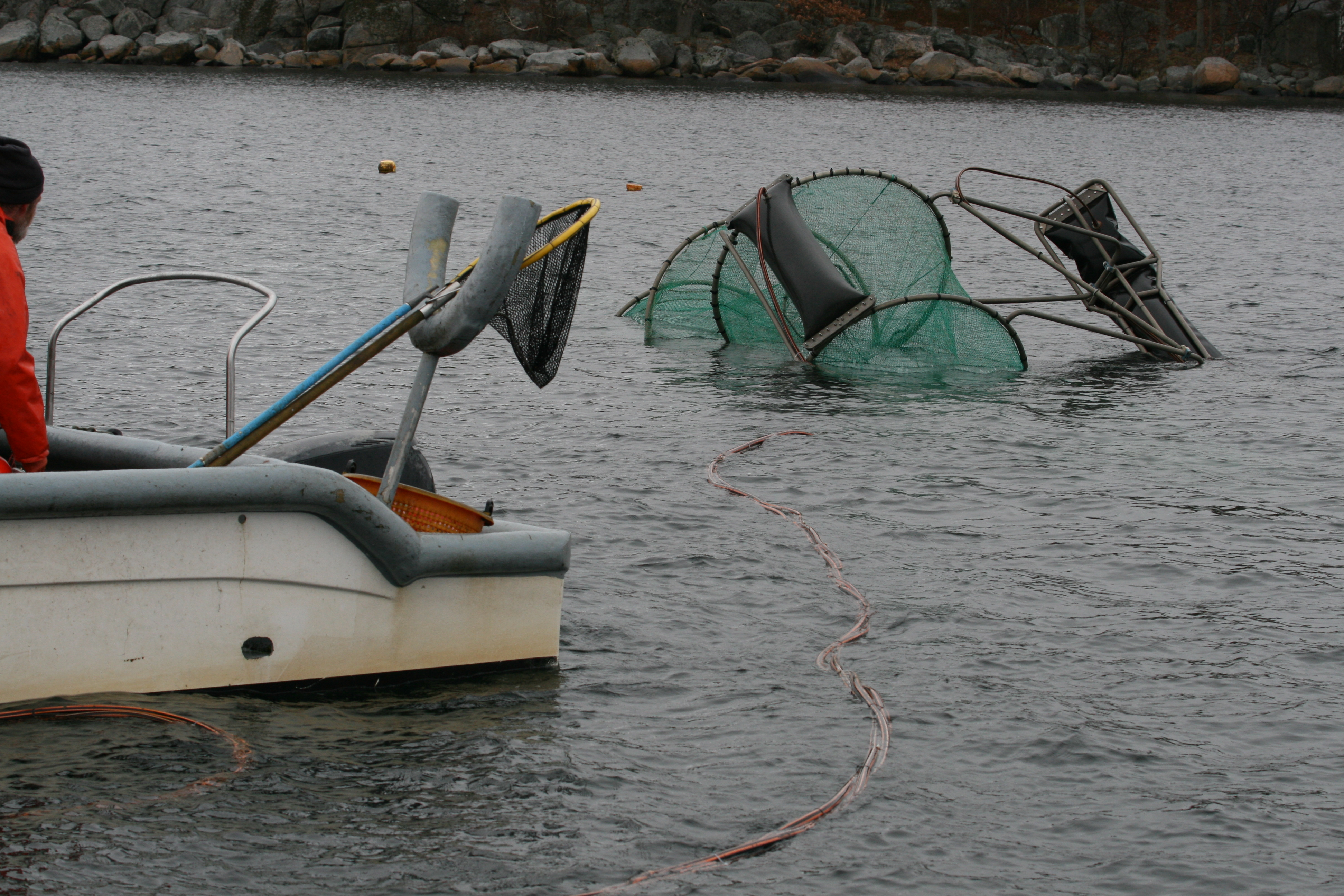
Photos: in the first stage of the retrieval operation of the pontoon trap, one needs to install pneumatic lines to the generator. Raising the cage takes about 10 minutes. First, the upper air bag is pumped up, then the lower skids, but as one can see, the pontoon trap does not rise evenly.
Although there was not a lot of fish in the pontoon trap and the gear was provided with a special channel that would theoretically help to take the catch, Glenn had to move along the trap a few times to move the fish from the rest of the cage towards the bag. It took another 10 minutes. Sinking the trap was also slow and with some problems – he had to use his leg to sink one side of the gear, which did not look safe even on calm water.
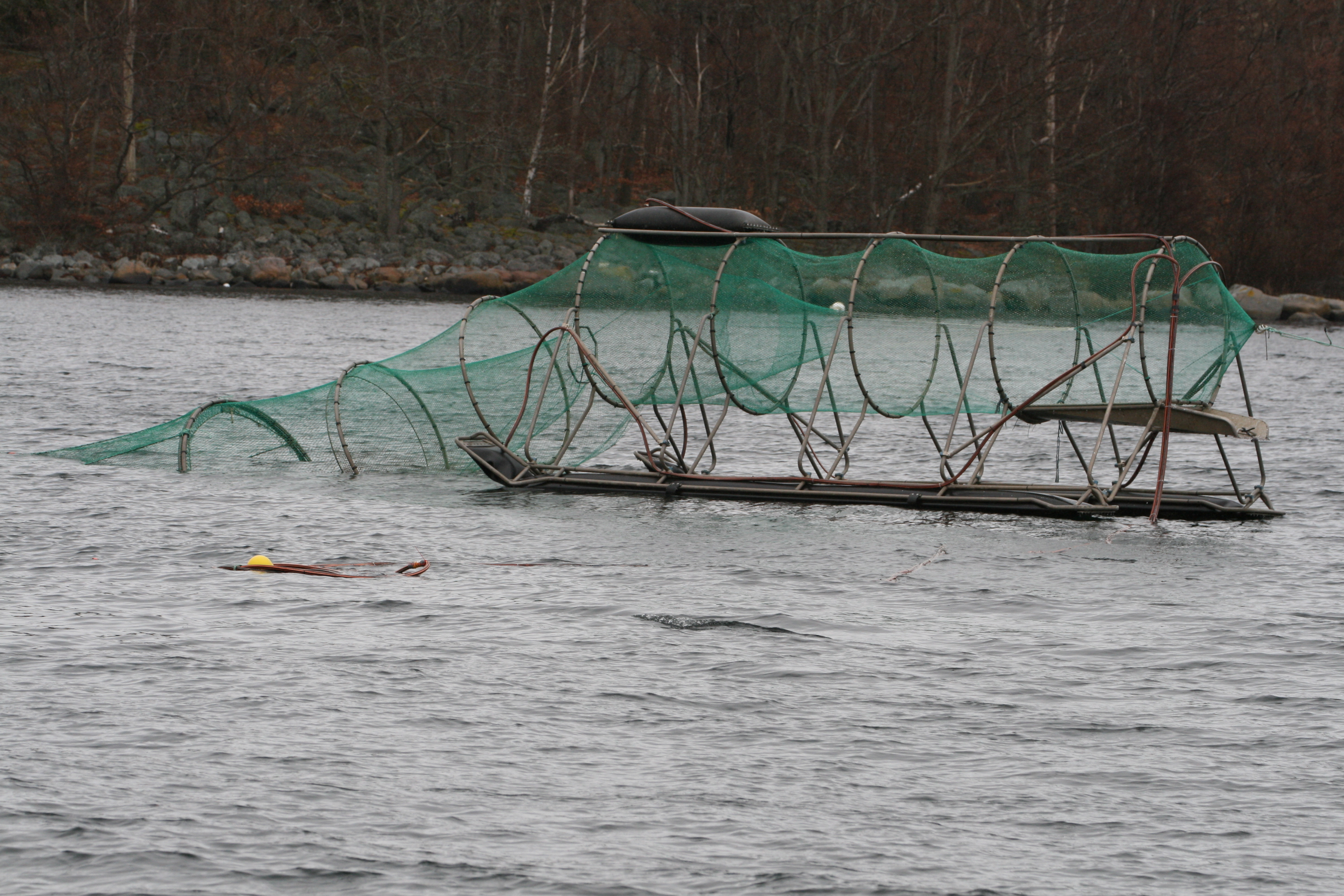
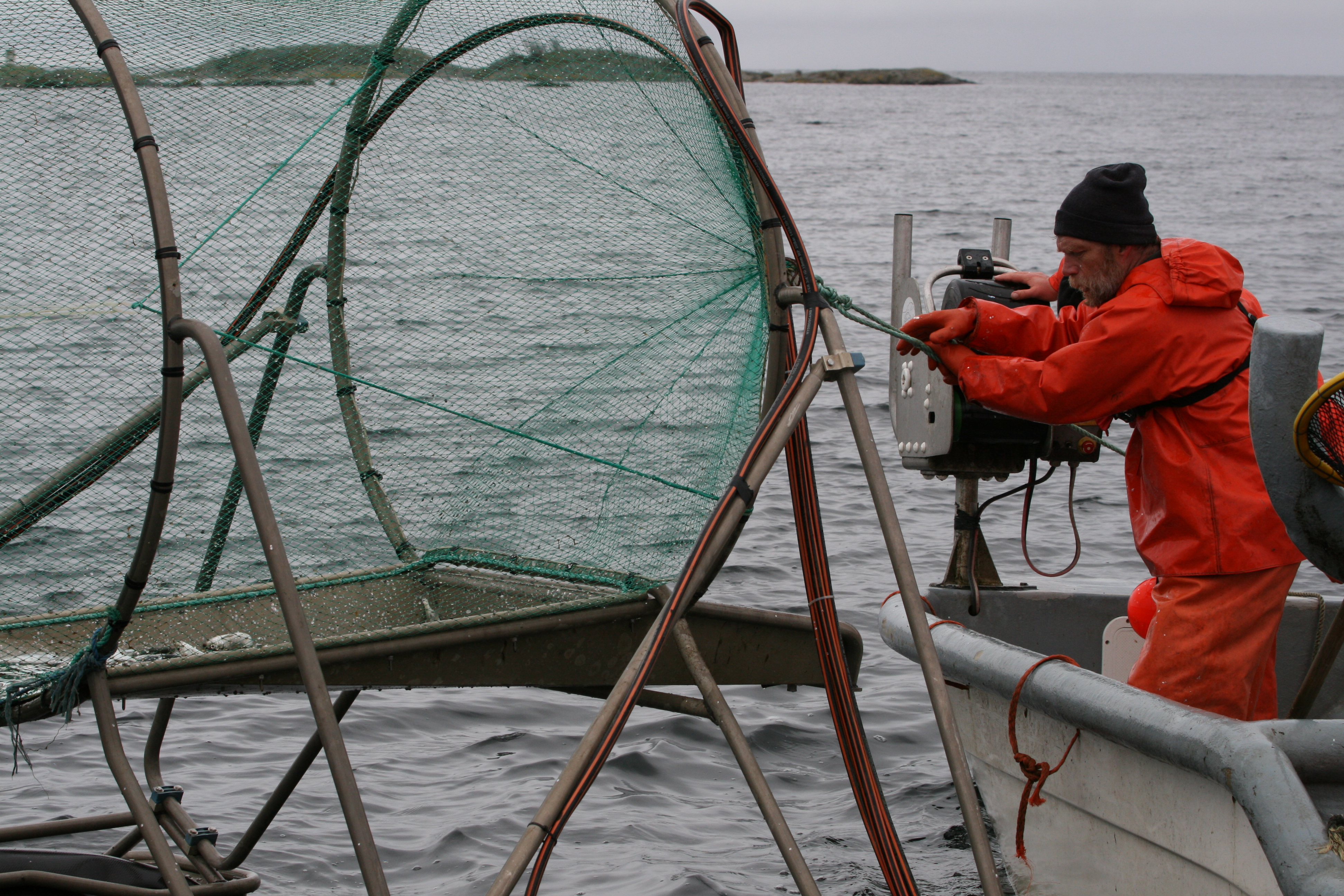
Photos: pontoon trap on the water surface. The whole catch operation took about half an hour.
Upon returning to Järnavik we discussed in detail what we saw on the water. The fisherman from Ystad – Bengt Andersson joined us. Polish fishers were somewhat less sceptical of new gears – they are still convinced that they are less efficient and more difficult to operate compared to set nets. However, the view of cod inside convinced them that it is at least worth trying to test the cages. Bengt Larsson told us clearly – “You are now in a situation we were here in Sweden seven years ago. We had only several seals. Now no one is able to catch with nets, fishing is possible only with gears resistant to seal attacks.” The Swedes emphasized that SLU projects enabled them to test different ideas that were not always successful. Those that have passed tests in practice – like small cod cages – are used also by other fishers, including those who do not cooperate within the project. Nevertheless, the profitability of coastal fisheries catches is ensured primarily by higher sales prices – “ecological” – fresh fish from local fishing grounds are sold for higher prices.
In view of a growing problem of fish being damaged in nets by seals, which may be to a certain extent mitigated by forecast compensations within the Operational Programme “Fish”, the representatives of the Polish coastal fisheries agreed that it is worth engaging in projects similar to Swedish solutions. The NMFRI, SLU Aqua and LIFE organisation intend to support and to cooperate with them.



